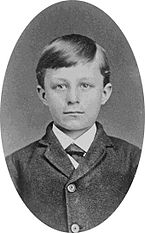Wright brothers
The Wright brothers, Orville (August 19, 1871 – January 30, 1948) and Wilbur (April 16, 1867 – May 30, 1912), were two American brothers, inventors, and aviation pioneers who are credited with inventing and building the world's first successful airplane and making the first controlled, powered and sustained heavier-than-airhuman flight, on December 17, 1903. From 1905 to 1907, the brothers developed their flying machine into the first practical fixed-wing aircraft. Although not the first to build and fly experimental aircraft, the Wright brothers were the first to invent aircraft controls that made fixed-wing powered flight possible.
The brothers' fundamental breakthrough was their invention of three-axis control, which enabled the pilot to steer the aircraft effectively and to maintain its equilibrium. This method became and remains standard on fixed-wing aircraft of all kinds. From the beginning of their aeronautical work, the Wright brothers focused on developing a reliable method of pilot control as the key to solving "the flying problem". This approach differed significantly from other experimenters of the time who put more emphasis on developing powerful engines. Using a small homebuilt wind tunnel, the Wrights also collected more accurate data than any before, enabling them to design and build wings and propellers that were more efficient than any before. Their first U.S. patent, 821,393, did not claim invention of a flying machine, but rather, the invention of a system of aerodynamic control that manipulated a flying machine's surfaces
They gained the mechanical skills essential for their success by working for years in their shop with printing presses, bicycles, motors, and other machinery. Their work with bicycles in particular influenced their belief that an unstable vehicle like a flying machine could be controlled and balanced with practice. From 1900 until their first powered flights in late 1903, they conducted extensive glider tests that also developed their skills as pilots. Their bicycle shop employee Charlie Taylor became an important part of the team, building their first airplane engine in close collaboration with the brothers.
The Wright brothers' status as inventors of the airplane has been subject to counter-claims by various parties. Much controversy persists over the many competing claims of early aviators. Historian Edward Roach argues that they were excellent self-taught engineers with a knack for tinkering more than for systematic research, but they proved to be poor businessmen.
Childhood
The Wright brothers were two of seven children born to Milton Wright (1828–1917), of English and Dutch ancestry, and Susan Catherine Koerner (1831–1889), of German andSwiss ancestry. Wilbur was born near Millville, Indiana, in 1867; Orville in Dayton, Ohio, in 1871. The brothers never married. The other Wright siblings were named Reuchlin (1861–1920), Lorin (1862–1939), Katharine (1874–1929), and twins Otis and Ida (born 1870, died in infancy). In elementary school, Orville was given to mischief and was once expelled. The direct paternal ancestry goes back to a Samuel Wright (b. 1606 in Essex, England) who sailed to America and settled in Massachusetts in 1636.
In 1878 their father, who traveled often as a bishop in the Church of the United Brethren in Christ, brought home a toy "helicopter" for his two younger sons. The device was based on an invention of French aeronautical pioneer Alphonse Pénaud. Made of paper, bamboo and cork with a rubber band to twirl its rotor, it was about a foot long. Wilbur and Orville played with it until it broke, and then built their own.In later years, they pointed to their experience with the toy as the initial spark of their interest in flying.
Early career and research
Both brothers attended high school, but did not receive diplomas. The family's abrupt move in 1884 from Richmond, Indiana to Dayton, Ohio, where the family had lived during the 1870s, prevented Wilbur from receiving his diploma after finishing four years of high school. The diploma was awarded to Wilbur on April 16, 1994, his 127th birthday.
In late 1885 or early 1886 Wilbur was struck in the face by a hockey stick while playing an ice-skating game with friends, resulting in the loss of his front teeth. He had been vigorous and athletic until then, and although his injuries did not appear especially severe, he became withdrawn, and did not attend Yale as planned. Instead, he spent the next few years largely housebound, caring for his mother who was terminally ill with tuberculosis, and reading extensively in his father's library. He ably assisted his father during times of controversy within the Brethren Church, but also expressed unease over his own lack of ambition.
Orville dropped out of high school after his junior year to start a printing business in 1889, having designed and built his own printing press with Wilbur's help. Wilbur joined the print shop, and in March the brothers launched a weekly newspaper, the West Side News. Subsequent issues listed Orville as publisher and Wilbur as editor on the masthead. In April 1890 they converted the paper to a daily, The Evening Item, but it lasted only four months. They focused on commercial printing afterward. One of their clients for printing jobs was Orville's friend and classmate in high school, Paul Laurence Dunbar, who rose to international acclaim as a ground-breaking African-American poet and writer. For a brief period the Wrights printed theDayton Tattler, a weekly newspaper that Dunbar edited.






